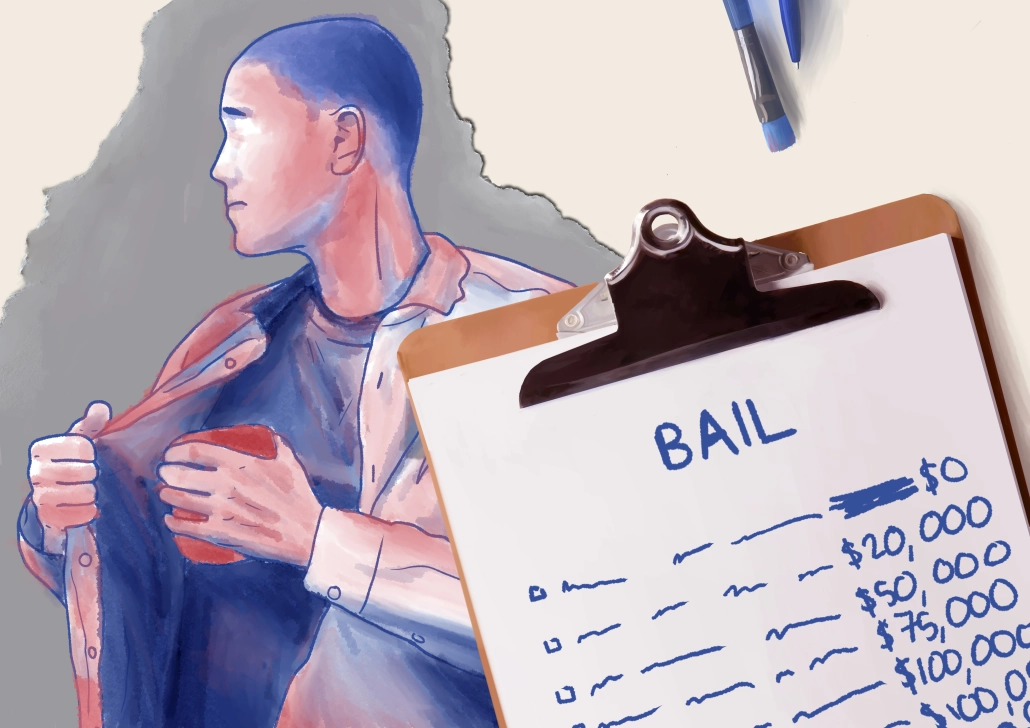PUBLIC DISCLOSURE
Bail, bonds and a big conversation
Los Angeles’ new zero bail policy is sparking heated debate across the city.
Los Angeles’ new zero bail policy is sparking heated debate across the city.


Following up from “Public Disclosure”’s last installment on statewide crime policy, I’d be remiss if I moved on without discussing some important local developments on our own city’s criminal justice environment — namely, our local bail laws.
In the last year alone, Los Angeles has seen a 52% increase in store robberies for both felonies and misdemeanors — with only about 10% leading to an actual arrest. But why is the rate so low, and could it be contributing to the uptick we’ve seen in smash-and-grabs around the city? To answer that question, we’ve got to contextualize it with a law about to take effect Oct. 1 — the zero-bail system.
Prior to this law, the way bail worked in the state of California was pretty straightforward. If you got arrested and charged with a crime, a certain money amount will be on a bail schedule next to that specific offense; it’s essentially a list of “prices” that can be posted for you to await your trial date outside of a jail cell with the promise you’ll reappear in court, which is returned to you if you’re found not guilty.
There are some traditional exceptions that are made to deny an arrestee bail if they’ve been deemed a flight risk or if they’ve committed a certain classification of a crime (felony or misdemeanor, violent or non-violent, pansy-ass or think-you’re-a-tough-guy-huh) — and this summer, what crimes do or do not fall in that list make up the zero bail system taking effect soon.
Aside from containing the complete list of money amounts for every crime in the book, the 2022 L.A. County Felony Bail Schedule has a computation sheet that can raise an already hefty amount for a felony even higher, depending on a judge’s discretion on the case as well as the offense’s … “enhancements.” Was the offense committed for the benefit of a gang? Add $40,000 to the presumed bail. Has the arrestee served a prison term during the past five years? Add $10,000. It’s the county’s most destructive choose-your-own-adventure novel.
But even more essential to understanding our bail system here and across many states is knowing that rarely do arrestees actually pay these prices — bail bonds usually rise to the occasion as a way of ensuring defendants appear in court. This kind of bond, known as a surety bond, allows the defendant to pay a bondsman 10% of the calculated bail for their crimes in exchange for the business itself to post the full amount. Other ways of posting bail in California include property bonds — where you use your equity in real property as collateral — or using cash.
As you might’ve guessed, this system, especially the use of cash bail, has received backlash for years as being unfair toward defendants — especially those who are low-income, those who committed nonviolent offenses, job seekers, students and people without alternative childcare options if they are sent to jail. Most crimes are not committed by those who have thousands of dollars of disposable income that could be spent to post bail or by people who own a lot of real property equity to begin with — to quote my “Crime and Public Policy” professor, crime itself is about the “haves” and the “have-nots.”
The new zero bail policy, instituted during the coronavirus pandemic to ease overcrowding in jails, pretty much eliminates this punishment for most low-level misdemeanors and nonviolent felonies, including things like theft, traffic offenses, vandalism or possession of a controlled substance, to name a few. Instead, during the typical two-to-five-day period that a defendant waits to be arraigned in jail, they will be released until their court date.
Many have lauded the new policy as a way to decriminalize minor offenses, with Illinois even becoming the first state to abolish cash bail statewide — yet stakeholders in L.A. are nowhere near a consensus.
A Superior Court judge in L.A. County recently issued a fascinating preliminary injunction preventing the city and county from enforcing the old money bail system for these crimes, declaring it unconstitutional. His decision cited many academic studies that have, in his words, showed that “money bail regimes are associated with increased crime and increased FTAs [failures to appear] as compared with unsecured bail or release on non-financial conditions.”
Yet Deputy District Attorney Eric Siddall criticized the judge’s decision, citing the lack of evidence the judge had in support of the current cash bail system’s effectiveness.
“It’s 100% ‘catch and release,’” Siddall said in an interview with Spectrum News 1 in May. “That’s basically going to be the policy of Los Angeles County for lower-level felonies and most misdemeanors. You do a smash-and-grab, you’re going to be released in time to do a second one on the same day.”
With so many opinions swirling on the nature of punishment, it’s time for us to start asking questions — and to take the next few months to observe how the city’s official start to the zero-bail system affects law enforcement, recidivism (how likely a criminal is to reenter the justice system) and the rate at which nonviolent offenses are committed. We’ll also need to weed out other correlative factors about smash-and-grab upticks, poor arrest rates and debate critically about what truly works in our criminal justice system — not just stick to the narrative that might make us feel the most comfortable.
Reform has rarely been comfortable, uncomplicated or perfect when it comes around the corner — and our bail system is no exception.
CJ Haddad is a junior writing about local, state and federal laws we use in our daily lives. She is also an associate managing editor at the Daily Trojan. Her column, “Public Disclosure,” runs every other Thursday.
We are the only independent newspaper here at USC, run at every level by students. That means we aren’t tied down by any other interests but those of readers like you: the students, faculty, staff and South Central residents that together make up the USC community.
Independence is a double-edged sword: We have a unique lens into the University’s actions and policies, and can hold powerful figures accountable when others cannot. But that also means our budget is severely limited. We’re already spread thin as we compensate the writers, photographers, artists, designers and editors whose incredible work you see in our daily paper; as we work to revamp and expand our digital presence, we now have additional staff making podcasts, videos, webpages, our first ever magazine and social media content, who are at risk of being unable to receive the compensation they deserve.
We are therefore indebted to readers like you, who, by supporting us, help keep our paper daily (we are the only remaining college paper on the West Coast that prints every single weekday), independent, free and widely accessible.
Please consider supporting us. Even $1 goes a long way in supporting our work; if you are able, you can also support us with monthly, or even annual, donations. Thank you.
This site uses cookies. By continuing to browse the site, you are agreeing to our use of cookies.
Accept settingsDo Not AcceptWe may request cookies to be set on your device. We use cookies to let us know when you visit our websites, how you interact with us, to enrich your user experience, and to customize your relationship with our website.
Click on the different category headings to find out more. You can also change some of your preferences. Note that blocking some types of cookies may impact your experience on our websites and the services we are able to offer.
These cookies are strictly necessary to provide you with services available through our website and to use some of its features.
Because these cookies are strictly necessary to deliver the website, refusing them will have impact how our site functions. You always can block or delete cookies by changing your browser settings and force blocking all cookies on this website. But this will always prompt you to accept/refuse cookies when revisiting our site.
We fully respect if you want to refuse cookies but to avoid asking you again and again kindly allow us to store a cookie for that. You are free to opt out any time or opt in for other cookies to get a better experience. If you refuse cookies we will remove all set cookies in our domain.
We provide you with a list of stored cookies on your computer in our domain so you can check what we stored. Due to security reasons we are not able to show or modify cookies from other domains. You can check these in your browser security settings.
These cookies collect information that is used either in aggregate form to help us understand how our website is being used or how effective our marketing campaigns are, or to help us customize our website and application for you in order to enhance your experience.
If you do not want that we track your visit to our site you can disable tracking in your browser here:
We also use different external services like Google Webfonts, Google Maps, and external Video providers. Since these providers may collect personal data like your IP address we allow you to block them here. Please be aware that this might heavily reduce the functionality and appearance of our site. Changes will take effect once you reload the page.
Google Webfont Settings:
Google Map Settings:
Google reCaptcha Settings:
Vimeo and Youtube video embeds:
The following cookies are also needed - You can choose if you want to allow them:
